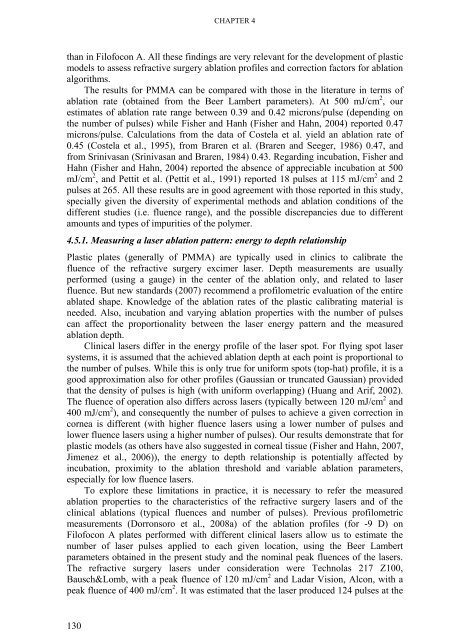Low_resolution_Thesis_CDD_221009_public - Visual Optics and ...
Low_resolution_Thesis_CDD_221009_public - Visual Optics and ...
Low_resolution_Thesis_CDD_221009_public - Visual Optics and ...
Create successful ePaper yourself
Turn your PDF publications into a flip-book with our unique Google optimized e-Paper software.
CHAPTER 4<br />
than in Filofocon A. All these findings are very relevant for the development of plastic<br />
models to assess refractive surgery ablation profiles <strong>and</strong> correction factors for ablation<br />
algorithms.<br />
The results for PMMA can be compared with those in the literature in terms of<br />
ablation rate (obtained from the Beer Lambert parameters). At 500 mJ/cm 2 , our<br />
estimates of ablation rate range between 0.39 <strong>and</strong> 0.42 microns/pulse (depending on<br />
the number of pulses) while Fisher <strong>and</strong> Hanh (Fisher <strong>and</strong> Hahn, 2004) reported 0.47<br />
microns/pulse. Calculations from the data of Costela et al. yield an ablation rate of<br />
0.45 (Costela et al., 1995), from Braren et al. (Braren <strong>and</strong> Seeger, 1986) 0.47, <strong>and</strong><br />
from Srinivasan (Srinivasan <strong>and</strong> Braren, 1984) 0.43. Regarding incubation, Fisher <strong>and</strong><br />
Hahn (Fisher <strong>and</strong> Hahn, 2004) reported the absence of appreciable incubation at 500<br />
mJ/cm 2 , <strong>and</strong> Pettit et al. (Pettit et al., 1991) reported 18 pulses at 115 mJ/cm 2 <strong>and</strong> 2<br />
pulses at 265. All these results are in good agreement with those reported in this study,<br />
specially given the diversity of experimental methods <strong>and</strong> ablation conditions of the<br />
different studies (i.e. fluence range), <strong>and</strong> the possible discrepancies due to different<br />
amounts <strong>and</strong> types of impurities of the polymer.<br />
4.5.1. Measuring a laser ablation pattern: energy to depth relationship<br />
Plastic plates (generally of PMMA) are typically used in clinics to calibrate the<br />
fluence of the refractive surgery excimer laser. Depth measurements are usually<br />
performed (using a gauge) in the center of the ablation only, <strong>and</strong> related to laser<br />
fluence. But new st<strong>and</strong>ards (2007) recommend a profilometric evaluation of the entire<br />
ablated shape. Knowledge of the ablation rates of the plastic calibrating material is<br />
needed. Also, incubation <strong>and</strong> varying ablation properties with the number of pulses<br />
can affect the proportionality between the laser energy pattern <strong>and</strong> the measured<br />
ablation depth.<br />
Clinical lasers differ in the energy profile of the laser spot. For flying spot laser<br />
systems, it is assumed that the achieved ablation depth at each point is proportional to<br />
the number of pulses. While this is only true for uniform spots (top-hat) profile, it is a<br />
good approximation also for other profiles (Gaussian or truncated Gaussian) provided<br />
that the density of pulses is high (with uniform overlapping) (Huang <strong>and</strong> Arif, 2002).<br />
The fluence of operation also differs across lasers (typically between 120 mJ/cm 2 <strong>and</strong><br />
400 mJ/cm 2 ), <strong>and</strong> consequently the number of pulses to achieve a given correction in<br />
cornea is different (with higher fluence lasers using a lower number of pulses <strong>and</strong><br />
lower fluence lasers using a higher number of pulses). Our results demonstrate that for<br />
plastic models (as others have also suggested in corneal tissue (Fisher <strong>and</strong> Hahn, 2007,<br />
Jimenez et al., 2006)), the energy to depth relationship is potentially affected by<br />
incubation, proximity to the ablation threshold <strong>and</strong> variable ablation parameters,<br />
especially for low fluence lasers.<br />
To explore these limitations in practice, it is necessary to refer the measured<br />
ablation properties to the characteristics of the refractive surgery lasers <strong>and</strong> of the<br />
clinical ablations (typical fluences <strong>and</strong> number of pulses). Previous profilometric<br />
measurements (Dorronsoro et al., 2008a) of the ablation profiles (for -9 D) on<br />
Filofocon A plates performed with different clinical lasers allow us to estimate the<br />
number of laser pulses applied to each given location, using the Beer Lambert<br />
parameters obtained in the present study <strong>and</strong> the nominal peak fluences of the lasers.<br />
The refractive surgery lasers under consideration were Technolas 217 Z100,<br />
Bausch&Lomb, with a peak fluence of 120 mJ/cm 2 <strong>and</strong> Ladar Vision, Alcon, with a<br />
peak fluence of 400 mJ/cm 2 . It was estimated that the laser produced 124 pulses at the<br />
130











